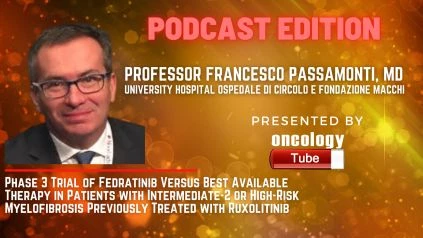Dr. Francesco Passamonti is the Director of the University Hospital of Varese’s Hematology Division. He earned his medical degree from the University of Pavia and went on to become a hematology expert. He served as a hematologist at the Policlinico San Matteo in Pavia, Italy, and as an assistant professor of hematology at the University of Pavia. He serves on the International Working Group on Myeloproliferative Research and Treatment (IWGMRT) Board of Directors, as well as the European LeukemiaNet Work Package 9 for MPN and the GIMEMA Working Party for MPN. He has published over 170 publications on MPN and other hematological malignancies as an author or co-author. He helped to the definition of molecular foundation of MPNs and he designed new prognostic models for MPNs. He conducts phase I to phase 3 clinical trials in MPNs with JAK2 inhibitors, HDACi, and IMiDs. In this video Dr. Passamonti discusses A Randomized, Phase 3 Trial of Fedratinib Versus Best Available Therapy in Patients with Intermediate-2 or High-Risk Myelofibrosis Previously Treated with Ruxolitinib (FREEDOM2).
Background: Until recently, the only medicine licensed for the treatment of intermediate- or high-risk myelofibrosis was ruxolitinib (RUX) (MF). Due to a lack of response, efficacy decrease, or intolerance, many patients stop taking RUX. Fedratinib (INREBIC) is a selective kinase inhibitor that works against mutant and wild-type JAK2 and FLT3 in the body. Fedratinib is approved as a front-line therapy in the United States, Canada, the European Union, the United Kingdom, and other countries for the treatment of patients with JAK-inhibitor-naive MF and those who have previously received RUX. Fedratinib 400 mg/day (starting dose) in patients with MF who were relapsed, resistant, or intolerant to previous RUX produced a spleen volume response in 31% of patients and a symptom response in 27% of patients in the single-arm, phase 2 JAKARTA2 trial (Harrison, Am J Hematol 2020). In JAKARTA2, gastrointestinal (GI) problems were among the most often reported adverse events (AEs) with fedratinib treatment. Fedratinib was placed on hold in November 2013 due to suspected cases of Wernicke encephalopathy (WE); the hold was later lifted, although fedratinib has limited long-term evidence, including survival outcomes. FREEDOM (NCT03755518) and FREEDOM2 (NCT03952039) are two phase 3 trials evaluating the safety and efficacy of fedratinib in patients with MF who have previously been treated with RUX. These two trials, unlike previous fedratinib investigations, involve GI-directed mitigation methods as well as thiamine monitoring and supplementation. Preliminary results from the single-arm FREEDOM study demonstrate that these mitigation techniques lower the occurrence of GI AEs (Gupta, CLML 2020). The FREEDOM2 trial, the first to test fedratinib vs. active MF treatments, is described here, along with the study design and procedures.
Methods and Design of the Study: Patients with MF from the European Union, China, Russia, South Korea, and Australia are being enrolled in the ongoing multicenter, open-label, randomized, phase 3 FREEDOM2 experiment. Age of 18 years; primary, post-polycythemia vera (post-PV), or post-essential thrombocythemia (post-ET) MF; DIPSS Intermediate-2 or High-risk disease; splenomegaly, defined as a spleen volume of 450 cm3 by MRI/CT and a palpable spleen measuring 5 cm below the left costal margin; ECOG PS score of 2; and platelet count of (Figure). Patients must have been relapsed or refractory to prior RUX treatment for at least 3 months, or intolerant to RUX after 28 days of treatment (i.e., developed RBC transfusion reliance [2 units/month for at least 2 months] or grade 3 thrombocytopenia, anemia, or hematoma/hemorrhage).
In repeated 28-day treatment cycles, eligible patients are randomized 2:1 to receive fedratinib 400 mg/day or investigator-selected best available therapy (BAT), such as RUX or other licensed JAK inhibitors (Figure). At screening, end of cycles (EOC) 3, 6, 12, 18, 24, and at the end of treatment, an MRI/CT scan is used to determine the size of the spleen. The primary endpoint is the spleen volume response rate (SVRR), which is defined as the proportion of patients in each arm who achieve a 35 percent reduction in spleen volume from baseline at EOC6, and the key secondary endpoint is the MF symptom response rate, which is defined as the proportion of patients who achieve a 50 percent reduction in total symptom score (TSS) on the Myelofibrosis Symptom Assessment Form (MFSAF) from baseline at EOC6. Other secondary goals include spleen volume and symptom responses, spleen size reductions by palpation, overall and progression-free survival, effectiveness of GI AEs and WE risk mitigation techniques, patient-reported health-related quality of life (HRQoL) assessments, and safety. Relationships between fedratinib efficacy and prognostic markers (e.g., mutations) as well as pharmacodynamic activity are among the exploratory endpoints (eg, circulating cytokines, hematopoietic cell profiling). Patients in the BAT arm can switch to fedratinib after EOC6 or before EOC6 if they have verified splenomegaly progression.
The results of FREEDOM2, the first trial to compare fedratinib to other active MF treatments, are widely awaited. 135 patients had been randomized as of June 2021, with enrolment likely to be completed by the end of the year.

